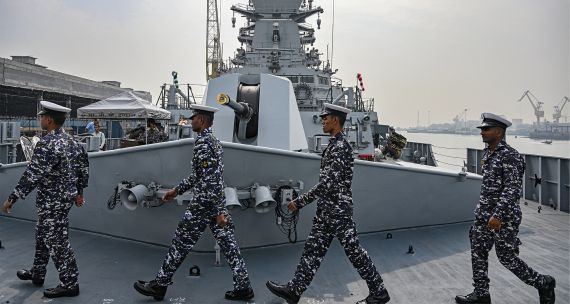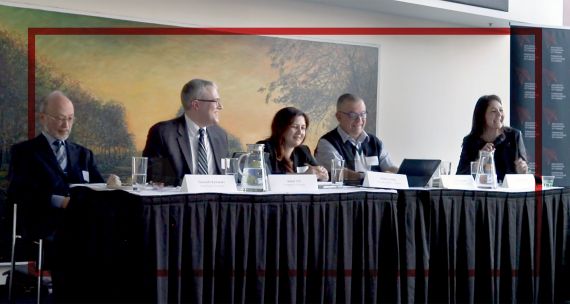An introductory note from Vina Nadjibulla, Vice-President Research & Strategy, APF Canada

To mark the one-year anniversary of Canada’s Indo-Pacific Strategy, the Asia Pacific Foundation of Canada (APF Canada) is launching a new series of reflections from our network of experts on the implementation of the strategy and its impact on Canada’s presence, reputation, and influence in the region.
The five contributions below are the first instalment in APF Canada’s Strategic Reflections series, with additional reflections in the coming months on China-Canada relations, Canada’s deepening engagement with South Korea, Japan, and Taiwan, and efforts to bolster Canada’s peace and security initiatives in the Indo-Pacific. The aim of this ongoing series is to present a variety of views and perspectives from APF Canada-affiliated scholars and experts, highlighting early successes and challenges in Canada’s efforts at becoming a more reliable and engaged player in the Indo-Pacific. APF Canada does not take institutional positions on specific elements of the IPS’s implementation, and the views expressed are those of the authors.
The reflection from Kai Ostwald focuses on the IPS’s impact in Southeast Asia, an area of growing importance to Canada and critical to the overall success of the strategy. The contribution from Patrick Leblond focuses on the second pillar of the IPS, which deals with trade, investment and supply chain resilience, where arguably Canada has made the most strides since the launch of the IPS. Karthik Nachiappan looks at Canada-India relations and the impact of the recent diplomatic crisis between the two countries on the overall implementation of the strategy. Bart Édes’ reflection highlights what Canada must do to build on the modest successes it has achieved in the Indo-Pacific to date. Finally, Deanna Horton’s reflection makes important linkages between Canada’s Indo-Pacific and Artic strategies and how to leverage complementarities between the two given resource and partnership constraints.
This Strategic Reflections initiative builds on earlier work from APF Canada, where we solicited analysis from our Distinguished Fellows and Canada-Asia Young Professionals Fellows following the November 27, 2022, announcement of Canada’s Indo-Pacific Strategy.
Kai Ostwald: Canada and ASEAN: The inaugural IPS year

Canada is one year into its ambitious Indo-Pacific Strategy (IPS), which calls for a “generational” response to the growing economic and geopolitical importance of the Indo-Pacific. Southeast Asia—also referred to as the ASEAN region in recognition of its regional association—lies at the heart of the Indo-Pacific and features centrally throughout the IPS.
There is a rich history of engagement between Canada and Southeast Asia that stretches back to the 1950s. Canada’s development assistance over several decades brought it extensive goodwill and the formal designation of Dialogue Partner for the Association of Southeast Asian Nations (ASEAN) in 1977. Its standing remained strong until the late-1990s, when Canada’s engagement became more episodic and narrowly focused on economic interests. From that followed an unfortunate—and unfortunately sticky—reputation as a fair-weather friend, prone to abrupt policy reversals as domestic political winds shifted.
This legacy has implications in that Canada must contend with a degree of skepticism in the sincerity of its Indo-Pacific ambitions and make up ground vis-à-vis other global actors whose presence in the region was steadier over the past decades.
The IPS’s inaugural year had clear positives. Both Prime Minister Justin Trudeau and Foreign Minister Mélanie Joly made symbolically important visits to the region, punctuated by headline-worthy statements about Canada’s aspirations for the relationship. Canada’s elevation to a “Strategic Partnership” with ASEAN in September is symbolically meaningful as well, even if the substantive implications are unclear. Progress on Canada-ASEAN free trade agreement (FTA) negotiations and several high-profile events, including APF Canada’s inaugural Canada-in-Asia Conference, further boosted Canada’s visibility in the region.
Positive as these developments are, they are preliminary signals rather than clear responses to lingering questions about Canada’s role in the region. Indeed, ambiguities abound. Southeast Asia remains apprehensive about the Indo-Pacific framework, given the region’s vulnerability to fallout from great power tensions. That leaves little interest in such things as “picking sides,” “decoupling,” “like-mindedness,” or other concepts that imply the inevitability of U.S.-China conflict. Given a choice, the region seeks broad-based engagement—including with China—that prioritizes development and avoids conflict. How will Canada balance those preferences with pressure from the U.S. to close ranks in response to China’s rise?
There is no clear answer, partly because it also remains ambiguous whether Canada aspires to the role of semi-autonomous middle power, or integral component of a grand U.S.-led initiative. Features of the two can be blended to some extent, but perceptions matter, and Canada will struggle to credibly occupy both profiles over the long run. As important is a related question on the minds of many in the region: why Canada? Southeast Asia has no shortage of potential partners looking to leverage the region’s strategic and economic opportunities. Canada can stand out from that crowd, but it has yet to articulate the coherent value proposition that makes clear how.
At least in Southeast Asia, Canada’s Indo-Pacific era is off to a promising start. To sustain this initial momentum, Canada must continue to show up in ways that boost its visibility across the region. Moreover, as the wave of forward-looking Indo-Pacific announcements gradually makes way for the new era’s quotidian reality, Canada must also begin to address the aforementioned ambiguities, lest its counterparts fall back on Canada’s reputation to fill in the blanks. There is, in short, little space for complacency.
Bart W. Édes: Canada’s Indo-Pacific Strategy: How to bounce back from a rough first year

It’s been a tough first year for Canada’s IPS, as relations with India took a steep nosedive. Canada is now burdened by simmering diplomatic tensions with Asia’s two giants, casting a pall over the overall strategy. Yet this difficult period must not halt efforts to reinvigorate areas of mutually beneficial co-operation with China and India, both on a bilateral basis and in a multilateral context. While Ottawa has paused trade talks with New Delhi, Canadian subnational governments, businesses, and educational institutions should continue to interact actively with the South Asian nation, which is Canada’s leading source for students and immigrants.
The successful conclusion of the 15th Conference of Parties (COP) to the UN Convention on Biological Diversity in December 2022 received less attention than it should. The COP was hosted in Montréal due to COVID restrictions in China, which nonetheless retained its role of chair. The resulting Kunming-Montréal Global Biodiversity Framework is a global success and came about in part due to close collaboration between Canadian and Chinese authorities. On the other hand, in June 2023, Canada halted all government-led activity at the Beijing-based Asian Infrastructure Investment Bank (AIIB). Disengagement with the institution harms Canada’s interests in the Asia Pacific region, where the AIIB finances projects in areas important to Ottawa, like climate change mitigation.
More positively, talks on trade and economic accords are proceeding apace with willing partners in Indonesia (individually) and ASEAN (including Indonesia). While the negotiations are very challenging, they are worth pursuing. ASEAN is on track to become the world’s fourth-largest economy by 2030. In 2022, merchandise trade between Canada and ASEAN reached C$40.7 billion. The agreement on an ASEAN-Canada Strategic Partnership in September 2023 was a significant milestone. Canada already has free trade agreements with some ASEAN states via the Comprehensive Progressive Agreement for Trans-Pacific Partnership. Ottawa must do more to gain greater benefits from this important accord, for which it will serve as chair in 2024.
The IPS expanded the geographic remit, and boosted the paid-in capital, of Canada’s development finance institution, FinDev Canada, so that it could support infrastructure development in the Indo-Pacific region. Today, FinDev boasts of a portfolio worth C$1.14 billion realized through signed commitments with 42 clients. Yet not one of these is based in Asia or the Pacific. The DFI needs to move faster to realize its expanded mandate.
Canada should capitalize on positive relations with Japan and South Korea to further develop economic ties and other areas of co-operation. In addition, as a complement to the IPS, intensified engagement should be sought with Central Asia, which has witnessed significant political and market reforms in its two biggest economies, Kazakhstan and Uzbekistan. Both welcome a diversification of their economic relationships to reduce dependency on China and Russia. There are opportunities in the region for Canadian firms in sectors such as mining, metallurgy, energy, and agriculture.
Yet, to realize the ambitions of the IPS, Canada must invest more resources into its implementation, continue to expand its regional presence, and be more active in Indo-Pacific forums and networks.
Patrick Leblond: Meeting the IPS’s objective on trade, investment and supply chain resilience: So far, so good

Canada’s Indo-Pacific Strategy (IPS) includes an objective of expanding trade, investment, and supply chain resilience. To do so, the IPS lists a number of initiatives and commitments. Overall, implementation of this objective has been impressive so far.
However, some of the initiatives described below, in fact, pre-date the launch of the IPS, thus making it difficult to ascertain to what extent progress can be directly attributed to the strategy. Nevertheless, we can confidently presume that the IPS gave these activities additional momentum.
On matters related to trade, in February 2023, Mary Ng, Minister of Export Promotion, International Trade and Economic Development, announced that the federal government was investing C$24 million to establish the Trade Gateway to Southeast Asia, which will be based in Singapore. That same month, she led the first Team Canada trade mission to the Indo-Pacific, also in Singapore, and in October and November, she led a second mission to Japan. In December 2022, one month after the IPS was published, Canada enhanced support for women entrepreneurs when Minister Ng participated in the Asia Pacific Foundation of Canada’s second women-only trade mission to Japan. These efforts at increasing trade with the Indo-Pacific are being bolstered by the appointment in September of Paul Thoppil as Canada’s new Indo-Pacific Trade Representative. He will be based in Jakarta.
At the APEC meeting in November 2023, Canada and its CPTPP partners agreed to the Terms of Reference for the CPTPP’s General Review, “a process meant to assess and improve the implementation and effective functioning of the Agreement.” In 2024, Canada will chair the CPTPP Commission, the body that governs the Agreement. At the APEC meeting in November 2023, Minister Ng launched the Indigenous Peoples Economic and Trade Cooperation Arrangement Partnership Council. Canada is still waiting for the U.S. to accept its request to join the U.S. Indo-Pacific Economic Framework for Prosperity (IPEF).
Canada has also improved market access through new comprehensive free trade agreements and new or modernized foreign investment promotion and protection agreements. In September 2023, Canada and ASEAN signed the aspirational ASEAN-Canada Strategic Partnership, which, among other things, calls for the “timely conclusion of an ASEAN-Canada Free Trade Agreement” (2025 is the target). When the IPS was launched, Canada and ASEAN had held two rounds of negotiations (August 2022 and November 2022). Since then, they have conducted three more rounds. Beyond ASEAN, Canada completed the negotiations of a foreign investment promotion and protection arrangement with Taiwan in October 2023.
The IPS includes several initiatives to strengthen the presence of Canada’s agriculture and agri-food sector in the Indo-Pacific region. One of these initiatives is the Indo-Pacific Agriculture and Agri-food Office (IPAAO). In December 2022 and January 2023, Marie-Claude Bibeau, then Minister of Agriculture and Agri-food, met with industry associations to “help inform [the IPAAO’s] early-stage planning and implementation.” On June 7, 2023, she announced that the IPAAO would be based in Manila and supported with C$31.8 million in federal government funding. In April 2023, Minister Bibeau also led a trade mission to Japan and Singapore.
On the digital front, the IPS calls for Canada to join the Digital Economy Partnership Agreement (DEPA) between Chile, New Zealand, and Singapore, following Minister Ng’s announcement, in May 2022, that Canada had submitted a formal request to launch accession negotiations. In August 2022, the DEPA Joint Committee “decided to commence the accession process for Canada.” Negotiations are still underway.
In the area of investment, FinDev Canada was given additional capitalization worth C$750 million to expand its activities in the Indo-Pacific. FinDev Canada focuses on sustainable infrastructure, agribusiness and forestry and associated value chains, and financial services. In May 2023, it signed a memorandum of agreement with the Asian Development Bank “to cooperate on sustainable and inclusive private sector investments that promote sustainable development in Asia and the Pacific.” As of November, it appears that FinDev had yet to make any investments in the Indo-Pacific.
Finally, on matters of strengthening supply chain resilience, Canada strengthened its science, technology, and innovation partnerships with Japan, signing two memoranda of co-operation: on Industrial Science and Technology and on Battery Supply Chains during the visit by Japan’s Minister of Economy, Trade and Industry, Yasutoshi Nishimura, to Ottawa in September 2023.
From the above, we can conclude that the Canadian federal government has been making good on its IPS commitments related to trade, investment, and supply chain resilience. As noted, some of these initiatives were underway prior to the IPS’s release and may have happened anyway. Nevertheless, the IPS might have given them greater impetus by making them more prominent in the public eye. The IPS certainly makes it easier to hold the federal government to account, regardless of when a particular commitment was launched.
Deanna Horton: Canada’s IPS and the Arctic

Canada’s Indo-Pacific Strategy (and that of the U.S.) is seen to be inextricably linked to its Arctic Strategy, both of which address regions of great strategic opportunities.
In an economic sense, apart from each other and Mexico, Canada and the U.S. are more intertwined with the Indo-Pacific than with any other region. Canada touts its membership in the Comprehensive and Progressive Agreement for Trans-Pacific Partnership (CPTPP), a free trade agreement among 11 nations (12 including the U.K.) that does not include China or the U.S. However, neither Canada nor the U.S. (nor India, for that matter) are members of the behemoth Regional Comprehensive Economic Partnership (RCEP), an economic grouping hovering at just under one-third of the global GDP and population. The Indo-Pacific Economic Framework (IPEF), an American initiative, has won adherents despite some criticism in Washington and in trade policy circles for its lack of market access to the U.S. Although Canada initially played down the IPEF’s relevance, of course, it has subsequently worked to gain entry.
On the Arctic front, Canada has its 2019 Arctic and Northern Policy Framework (ANPF). However, despite the Arctic’s importance to Canada, many Canadians – including many Canadian governments – do not view its governance and protection as a priority. As with the Indo-Pacific, Canada’s prioritization of the Arctic has fluctuated over the years, and government spending on the Arctic does not reflect the significance of the Northern Passage to Canadian sovereignty.
In 2013, the Arctic Council granted observer status to China, India, Japan, Singapore, and South Korea. These states have rapidly expanded their Arctic presence through unilateral, bilateral, and multilateral engagement, although less so in the case of India. These developments have added a new dimension to the concept of a “global Arctic” and shifted the Arctic’s strategic centre away from the region itself and toward the Indo-Pacific. With these five states developing Arctic capacities and interests, Canada and the U.S., among other Arctic nations, can no longer overlook non-Arctic Asian actors in their strategic approach to the region.
For Canada, while the IPS and ANPF are concerted efforts involving coalitions of government ministries and a co-ordination of these ministries’ strategic views, the limited resources that have been allocated for each means that the ultimate test of Ottawa’s willingness to make a meaningful contribution, gain the trust of regional partners, and bring about its Indo-Pacific and Arctic visions, will be in the implementation. For that, Canada will have to leverage its limited impact by maximizing complementarity with its partners.
Karthik Nachiappan: An ‘Indo'-less IPS

India featured prominently in Canada’s Indo-Pacific strategy (IPS). Unlike the Indo-Pacific strategies produced by Canada’s G7 partners, however, India did not feature as a geopolitical asset in which to invest. Rather, its importance to Canada was depicted as largely economic, as a thriving, rising Asian market. In other words, India was seen as representing an economic, not strategic, opportunity for Canada.
But this was a bet made on shaky political ground, given differences in characterization of the activities of Canada’s Sikh diaspora that have marred bilateral ties for decades. That bet, and possibly Canada’s IPS, now appear rudderless after Ottawa alleged the Indian government had a role in the killing of Hardeep Singh Nijjar in British Columbia. The murder and the unfolding crisis have dealt the relationship and the IPS a mighty blow.
Why did India feature heavily in the IPS? Western powers view India’s growing economic heft and military capabilities as integral to their efforts to balance and restrain China’s growing ascendance. Regardless of whether New Delhi can credibly deter Beijing, Canada’s allies all appear unified in strategically enabling India so they can lessen their burdens vis-à-vis China while also forging closer economic ties with India for their own domestic and strategic reasons. An economically dynamic India can also serve as an attractive long-term market while helping New Delhi finance its military capabilities to manage regional security challenges.
Similar logics could have influenced how Canada sought to engage India through its IPS, even if that engagement retained a heavy emphasis on economic matters. For Ottawa, increased trade with India would amplify and complement Canada’s robust pension fund investments. More trade would intensify links between highly innovative Indian and Canadian firms, creating networks of capital, ideas, and skilled professionals. Forging and deepening trade, however, hinges on a stable political compact, which the two countries lacked. The current crisis has laid bare the flaws of having a one-dimensional economic focus on India and not nesting that pillar within a strategic framework driven by shared interests and values.
The failure to craft a bilateral strategic framework with India before unveiling the IPS left the strategy open to the vagaries of the rocky relationship, namely fractious diaspora politics. Unsurprisingly, the first casualty of the current crisis was the talks that were meant to lead to an early progress trade agreement (EPTA). Ensuing diplomatic expulsions and withdrawals, moreover, have imperilled the burgeoning people-to-people ties through academic, cultural, research, and scientific exchanges. The lack of trust will inevitably defer bilateral discussions on shared challenges like supply chain resilience and climate change, both of which are key IPS priorities tied to India.
That said, it’s vital to see this seemingly generational impasse (perhaps a necessary one) as an opportunity to have the hard conversations that will help place the relationship on a sounder footing and keep it relatively immune from political irritants. That rapprochement could reinvigorate Canada’s IPS and enable it to tackle bilateral and regional priorities given India’s rise and size, its solid economic and critical military positions, and the faith Canada’s allies have in New Delhi as a balancer in the Indo-Pacific. A potential thaw, however, depends on what direction the Nijjar investigation takes and how New Delhi responds. Notwithstanding that outcome, it's unquestionable that Canada and India share interests, values, and the desire to collaborate in a fluid and volatile Indo-Pacific. It’s politics that gets in the way.










